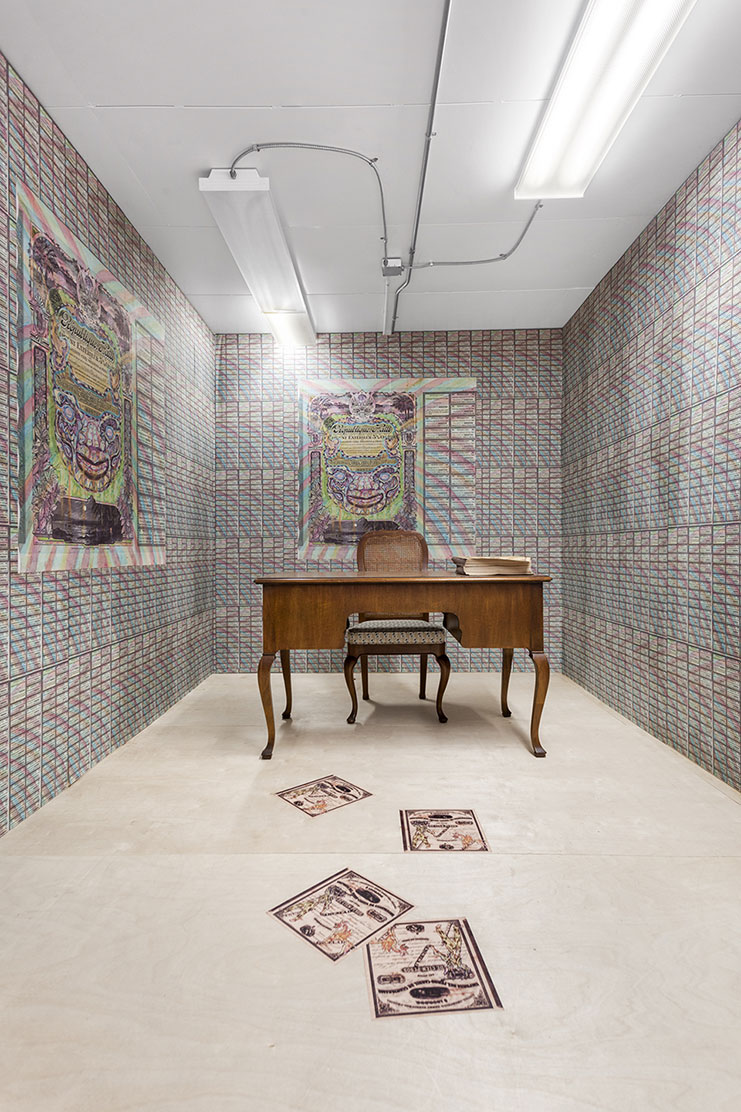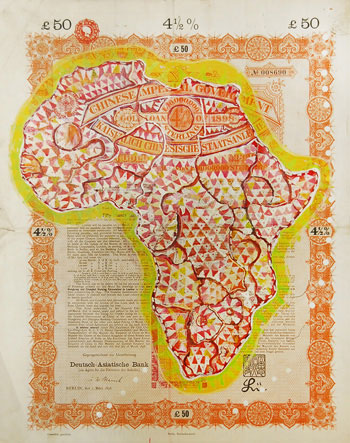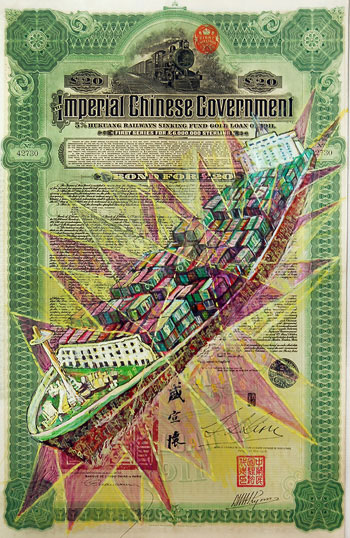
FRINGE Projects last month presented Reversal of Fortune, one of the latest series of site-specific work by internationally acclaimed London-based Guyanese artist, Hew Locke. The work, which is visible from the storefront windows of an empty jewelry store in Miami’s historic Alfred I. du Pont building, is an installation of modified share certificates that were scanned and printed in a similar method to advertising billboards. It uses this format to address themes of history and the global movement of money, power and ownership.

Share certificates are written documents signed on behalf of a corporation, which serve as legal proof of ownership of the number of shares indicated. Key information printed on those documents would typically include the name and address of the shareholder; the number of shares held; the class of shares and the amount paid on those shares. It was also common practice for companies to adorn their shares with the kind of bold typography and classical motifs that implied stability and worth. It is precisely that practice of adornment that has become central to the way Locke uses those documents to engage with themes of wealth, its [non]distribution and the [non]beneficiaries.
Since the global financial crash of 2008, Locke has been acquiring and modifying a number of original antique share certificates. Quite often his approach to working with these documents has included identifying aesthetic and historical content that resonate the most with his vision, and subsequently altering their surfaces with painted depictions of the local population in which the companies operated. For Locke, these are silent witnesses who contributed to the creation of wealth without receiving the benefit.
This series of work marks the continuation of Locke’s Gold Standard series and by its very nature also acknowledges the commodity value of contemporary art. Replicas of the shares are available to be taken by visitors from the vault as a means to further global currency circulation.

About the layered quality of his work Locke had the following to say, “I aim to create attractive work that engages people, and then surprise them with a disturbing element. I hope they start to question what the work is about – what is really going on beneath the surface.”
While there is an immediacy that is directly tied to the often monumental scale of his work, there is also an intimacy that reveals itself upon closer examination of his exhaustive attention to detail. It is the successful merger of these two methodologies that, in my opinion, allows the work to transcend time. The use of historical material, whether to engage with concepts of wealth, power or invented/imported cultures, work well to prove that these themes are just as relevant in the here and now as they were in the years prior.

The Reversal of Fortune installation will remain up until January 31, 2018, in the Alfred I. du Pont building, 169 E Flagler Street, Miami, FL.
Hew Locke (b. 1959 in Edinburgh, UK) is the eldest son of Guyanese sculptor Donald Locke (1930-2010) and Leila Locke nee Chaplin (1936-1992). He spent his formative years (1966-1980) in Georgetown, Guyana before returning to the UK to study. He obtained a B.A. Fine Art in Falmouth (1988) and an M.A. Sculpture at the Royal College of Art, London (1994). In 2000 he was the recipient of the Paul Hamlyn Award and the East International Award.
Locke’s work is represented in many collections including the Government Art Collection, the Pérez Art Museum Miami; the Tate Gallery; the Arts Council of England; the National Trust; the Brooklyn Museum, New York; the Kemper Museum of Contemporary Art, Kansas City; the RISD Museum, Rhode Island; the Victoria & Albert Museum; and the British Museum.




.png)









